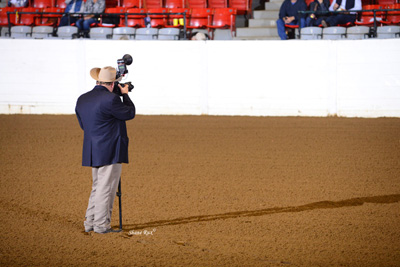 With the digital age came sweeping change for everyone, including photographers, and some of the impact was terrific. The upside that happened at horse shows was simply that everything suddenly became much more convenient.
With the digital age came sweeping change for everyone, including photographers, and some of the impact was terrific. The upside that happened at horse shows was simply that everything suddenly became much more convenient.
“What is positive about technology is that exhibitors can come to us at the show shortly after their event and view and order images taken during their classes,” says Don Trout, a professional photographer of more than 40 years. “If they don’t get a chance to view at the show, they can view them on our website. We try to post images on the website daily or within a few days of the shows being over. That way owners that are not able to be at the shows can view the images as well.”
Trout’s wife, Debbie, assists Don with all the tasks that don’t take place behind the camera, including helping customers view those proofs right at the show.
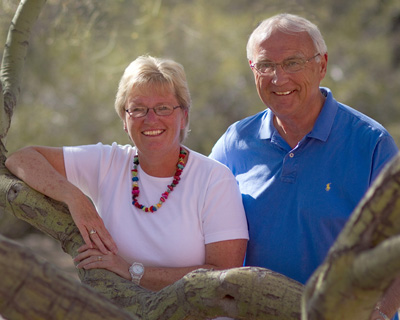
Don and Debbie Trout
Technology has also made it easier for photographers to produce a better product for exhibitors, according to Shane Rux, who is assisted in his business by his fiancé, trainer Julie Thompson, and a small staff.
“We’ve been able to improve our accuracy because of advances in technology, and we’re able to adjust lighting, become more efficient, and quality is improving,” he explains. “When we worked with film, the whole roll of film could get destroyed if you had a pinhole in there, or our lens could have been stuck the whole time without us knowing until the film came back – or the film could get lost or destroyed. You had to carry multiple of everything and check everything repeatedly. Digital is much more forgiving when it comes to lighting, and it gives you some peace of mind because you can store it immediately. The equipment has helped us immensely.”
On the flip side, technology became available to everyone, bringing competition from everywhere. Trout says that even though everyone has a camera or a smart phone or tablet, they are not going to produce as high a quality product as that done by a photographer.

Shane Rux & Julie Thompson
“As a professional horse photographer, we are hired to capture the best shot of your horse first,” he says. “This doesn’t happen with a point and shoot camera, iPhone or iPad.”
Rux says that even though he doesn’t have a problem with people taking their own photos of their own horses outside the ring, he concurs that a professional will still offer the experience of hand-eye coordination, and years of expert practice.
“Also, because I have been to some facilities multiple times, I start to have an idea of where to place things for the best lighting, and the best distance for that facility,” he explains.
What does help photographers is exhibitors using technology wisely by taking advantage of the accessibility to photos quickly, but in the right way. Before exhibitors post a proof or make a scan, there are some legal boundaries put in place many years ago as part of federal law.
“We understand everyone is a rush to post their winnings. Most of the time, show photographers can get you the digital image emailed for this use, in a timely matter. We post all of action shots on the website to view, but they must be purchased before posting on social media sites,” explain the Trouts. “Also, it is illegal to scan prints that you bought at the shows to post on social media. Purchasing a print copy does not authorize the right to scan the print. All professional photos are under copyright laws, so scanning the print is violating the U.S. Copyright Law.”
With technology also came some hidden costs, explains Rux. “You require more people to show all the proofs at the show, as well as equipment to do it. Now your costs have risen, even though you’re saving on lab costs, and you’re hiring more, putting more in hotels and expenses for staff – you didn’t have to have as much manpower before.”
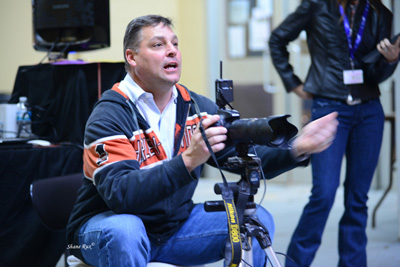 Rux says what hurts business more is a photographer who is a “scab,” who comes to the show to shoot and undercut, or give images away for free.
Rux says what hurts business more is a photographer who is a “scab,” who comes to the show to shoot and undercut, or give images away for free.
“All that does is drive the price up, and it might impact the availability of photographers at shows,” he explains. “I can appreciate people trying to earn a living or pick up a second job, but with that comes the etiquette expected of photographers, because it needs to be understood that it’s how we make our living. Even though grounds are often public, it has to come with some consequences, and one might be that eventually the professional photographer won’t be available, or what will be offered will be of much lesser quality. I don’t know necessarily who is out there to fill our shoes when we’re gone. Some of the young and up-and-coming guys have already felt the wrath, and don’t want the responsibility – they want to fly in and have low overhead, and undercut, and make their profit. A lot of times they have another job.”
 Both photographers agree that having show committees and producers support the official photographer is of utmost importance.
Both photographers agree that having show committees and producers support the official photographer is of utmost importance.
Trout explains, “What a show can do is to stand behind your official photographer, and not let poaching photographers come on the grounds, go through the barns soliciting work either on the grounds or off the grounds. Some of these folks that do this to the official photographer have day jobs and do photography on the weekends. They don’t do photography as a living. They also don’t have extra expense in shooting at someone else’s show. (They need to remember that they wouldn’t like it if the shoe was on the other foot).”
“The biggest misunderstanding is that people assume we are getting paid to be at a show,” Rux reveals. “In fact, we are providing a service to the exhibitors and we are bidding them out in contracts. So we are spending money, giving sponsorships, and a lot of times, all the winners’ photos, and on top of that, we are not getting paid. Usually, we are already in the hole once we get to the show. People don’t understand that we are putting out a lot of funds and time and expense hoping the show will produce at least what we’ve already put into it, and a profit on top of it.
It’s a gamble every time a photographer goes to a show.
“As a professional photographer, this is how we make our living. We put in long hours at the shows, being there before the show starts each day and still there when the show finishes each day, every day of the show. What we sell at the shows, is what we make,” echos Trout. “We have to pay our own expenses to and from the shows. We also have insurance premiums on our equipment, also liability insurance on our business, and insurance on our vehicles. We hire extra staff at the larger shows and pay their expenses as well. Also, the photographers supply their own backdrops, flowers/plants, carpet, lighting, etc. which is another expense. So we have a large investment in each show before the show even starts.”
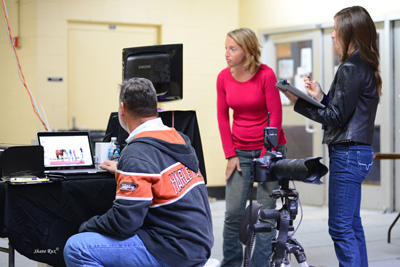 And if you are a budding photographer who is horse crazy, both Rux and Trout have some simple advice.
And if you are a budding photographer who is horse crazy, both Rux and Trout have some simple advice.
“Practice, practice, practice,” says Trout, “but not at shows where there is an official photographer working. You can go to your local ranches and friends’ barns and ask permission to practice shooting while they are working their horses. All you are doing is getting your timing down.”
If you are at an event, Rux explains, there’s a professional etiquette expected.
“I always tell anyone that’s interested to go to the photographer, and tell them why you are there. The worst thing you can do is have someone sneak around,” he says. “There’s a professionalism between photographers to let them know what your true intentions, and you shouldn’t have a problem approaching anyone, if that’s really your goal. If you love doing it, you should ask the official photographer if he or she has any advice, or if there are any shows to apprentice with that photographer. That’s going to be the best way to break into it.”
The importance of the photographer to the event has to do with the memories and good times for the exhibitor, but their presence has a much larger impact on the life of the show and industry itself.
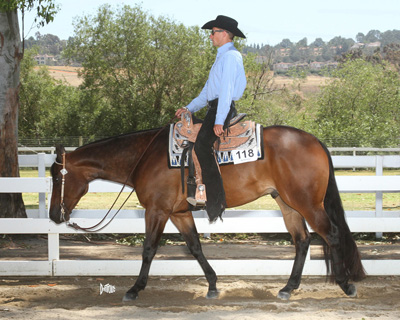 “I think the shows producers understand the position of the photographer in being able to build a show and progress it,” says Rux. “Every time people go through the magazines the photos peak their curiosity. People are a little more particular what shows they go to, because things costs more, and they still need the points, but they eventually go where they can get points and have fun, if it comes across in a magazine that it was that way through the photos, they may support that show. The saving grace for us is always the backdrop, because you don’t have the other competition and people still require and desire backdrop photos for ads, or souvenirs, and marketing.”
“I think the shows producers understand the position of the photographer in being able to build a show and progress it,” says Rux. “Every time people go through the magazines the photos peak their curiosity. People are a little more particular what shows they go to, because things costs more, and they still need the points, but they eventually go where they can get points and have fun, if it comes across in a magazine that it was that way through the photos, they may support that show. The saving grace for us is always the backdrop, because you don’t have the other competition and people still require and desire backdrop photos for ads, or souvenirs, and marketing.”
An image a show photographer takes is very much an asset for the industry according to Thompson, a trainer and multiple carded judge, who provides the customer service that they both believe in strongly as a part of the sustainability of the show photographer.
“Now that we’re working together, Shane gets to see all sides of the horse photography world,” Thompson says. “He sees the perspective of how photos play a role in sales for videos and websites, because a great photo will draw an eye to a sale horse instead of a bad conformation shot.”
The professional photographer is at the shows to capture memories and that special advertising photo while the exhibitors are showing, according to Trout. He also understands the importance of the backdrop and professional image to the show’s marketability and image.
“Most photographers will have a backdrop set up to take circuit champion/win photos for the exhibitors,” he says. “Having great circuit awards for the exhibitors encourages them to get their photos taken, that in return gets the show free advertising. When an official photographer has their backdrop set up, it is for their use only. (Example, you wouldn’t take your steak into a restaurant and use their grill to cook it!). Some people like to shoot off to the side of the backdrop and it’s not the best angle of the horse and rider or the best quality to post on social media, which also reflects back on the photographer and the show.”
 Despite the trials that taking photos in the 21st century delivers, Trout and Rux have a passion for their careers that shines through. For Trout, it’s the events they shoot that keep him challenged.
Despite the trials that taking photos in the 21st century delivers, Trout and Rux have a passion for their careers that shines through. For Trout, it’s the events they shoot that keep him challenged.
“I’m always trying every time to shoot a better shot than the last time,” he insists. “I still look at photos in the different publications and see what I like and what I don’t like. I always am shooting the conformation of the horse first, then the rider (as the rider knows what to do). Also, we have shot some of the best horses in the business and met the best people in this business! We always are happy when we have taken that special photo for our great customers.”
Rux has found that even though technology has provided some obstacles to his career, it also has kept him motivated.
“When we were shooting with film, you feel you reach a point where you can’t do anymore and have mastered it all,” he says. “Now I have to learn a whole new camera, and understand all the challenges that come with it, like updating software, computers, using social media, and more. Now it’s been a whole new competitive mechanism for me again, because I’ve had to change and grow with it. Before it was very hands -on, and with the changes now, we had to learn and reeducate ourselves, and has taken me to new levels, and there’s no stopping. Everything advances so quickly and every time it does, we have to stay with it.”
He also has found that, like Don Trout, it’s all about the people.
“Being with Julie now has really helped me – now I know what it is like to be on the exhibitor and trainer side of it,”he says. “We try to be fair, because now I know what it costs for stalls, shavings, having a horse go the vet, the haul fee and everything else. It helps me incorporate pricing, show specials for the exhibitor that fits into their budget, too, because you have people of all walks of life who do this.”
Rux says being with someone on both sides helps open his eyes to that perspective. “Even though I’ve been doing this since 1992, I’m still learning, and that’s what keeps it fun for me.”


You must be logged in to post a comment Login